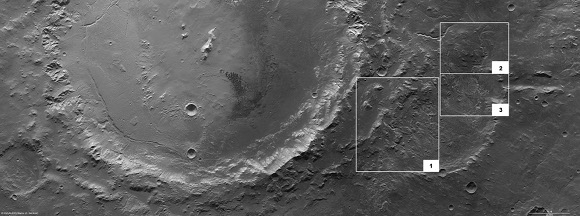This article is more than 1 year old
Ancient crater lake evidence found on Mars
Dusty bowl once filled with water, probe images show
A satellite from the European Space Agency (ESA) has photographed the meandering channels of a dried-out river on the surface of Mars.

The Eberswalde crater contains a rare case of a Martian delta (box 3). Channels (box 2) which fed the lake in the crater are very well-preserved. According to the ESA, the delta deposits and channels together provide a clear indication of liquid surface water during the early history of Mars. Photo by: ESA (click to enlarge)
Dark sediments lining the fanned-out delta at the corner of the Eberswalde crater show where little streams once flowed into a lake on Mars' rocky surface.
The photos come from the ESA's Mars Express, which has been focusing on the Eberswalde crater as one of four likely sites still showing evidence of water on Mars. NASA will be sending in a Rover to investigate one of them – The Gale Crater – later this year. Water still exists on Mars – frozen into permafrost and as a vapour in tiny quantities in the atmosphere – but it is believed that there were once oceans and lakes similar to Earth's.
The ESA described the findings: "Small, meandering feeder channels are visible towards the top of the crater, which would have filled it to form a lake."
The agency continued: "This delta structure, first identified with NASA’s Mars Global Surveyor spacecraft, is characteristic of the presence of a lake in the crater at that time. Such features provide a clear indication that liquid water flowed across the surface of Mars in the planet’s early history."
See photos from the Mars Express here. ®
